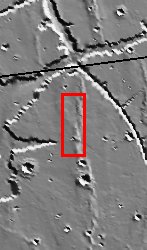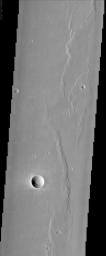- Original Caption Released with Image:
-

(Released 10 May 2002)
The Science
Wrinkle ridges are a very common landform on Mars, Mercury, Venus, and the Moon. These ridges are linear to arcuate asymmetric topographic highs commonly found on smooth plains. The origin of wrinkle ridges is not certain and two leading hypotheses have been put forth by scientists over the past 40 years. The volcanic model calls for the extrusion of high viscosity lavas along linear conduits. This thick lava accumulated over these conduits and formed the ridges. The other model is tectonic and advocates that the ridges are formed by compressional faulting and folding. Today's THEMIS image is of the ridged plains of Lunae Planum located between Kasei Valles and Valles Marineris in the northern hemisphere of the planet. Wrinkle ridges are found mostly along the eastern side of the image. The broadest wrinkle ridges in this image are up to 2 km wide. A 3 km diameter young fresh crater is located near the bottom of the image. The crater's ejecta blanket is also clearly seen surrounding the sharp well-defined crater rim. These features are indicative of a very young crater that has not been subjected to erosional processes.
The Story
The great thing about the solar system is that planets are both alike and different. They're all foreign enough to be mysterious and intriguing, and yet familiar enough to be seen as planetary "cousins." By comparing them, we can learn a lot about how planets form and then evolve geologically over time.
Crinkled over smooth plains, the long, wavy raised landforms seen here are called "wrinkle ridges," and they've been found on Mars, Mercury, Venus, and the Moon - that is, on rocky bodies that are a part of our inner solar system. We know from this observation that planets (and large-enough moons) follow similar processes. What we don't know for sure is HOW these processes work.
Scientists have been trying to understand how wrinkle ridges form for 40 years, and they still haven't reached a conclusion. That's the excitement of science, as the scientific hypotheses and debates continue. Geologists have narrowed down the possibilities to two likely candidates. On the one hand, a volcano could have sent thick streams of lava out that later hardened to form the ridges. On the other, a crushing tectonic force could have pushed the land together, causing it to fault and fold upward. Whichever theory is true, we do know the planet has been subjected to some tremendously active geologic shaping in its past.
Don't miss the nearly perfect crater near the bottom of the image. Its sharp crater rim tells us that it is probably pretty young as craters go, because erosion hasn't dulled its edges. Bright material also seems to form a dusty, hazy halo around it. That's all of the material that was blasted out of the crater and sprinkled back down around it in an "ejecta blanket." Seeing it so clearly, seemingly untouched by erosion, also indicates the crater's relative youth.
- Image Credit:
-
NASA/JPL/Arizona State University
Image Addition Date: -
2002-06-04
|

 Planetary Data System
Planetary Data System













